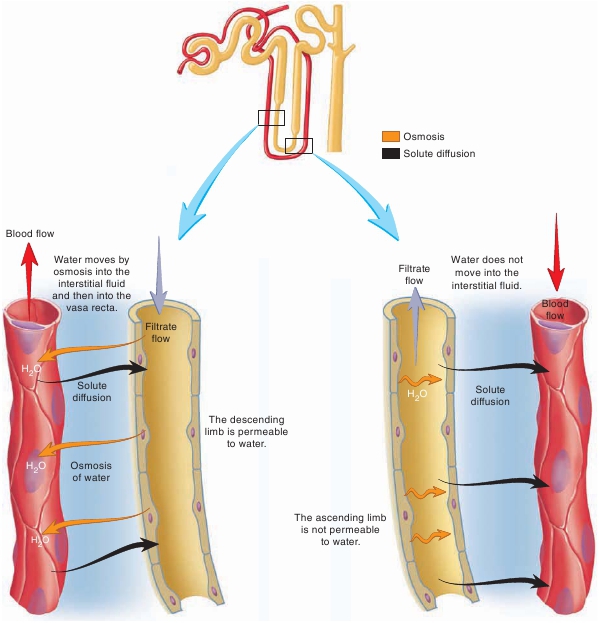974
PART 4 Regulation and Maintenance

Ascendingvasa recta
Interstitialfluid
Descendinglimb, loopof Henle
Thin segment Interstitial Descendingof ascending fluid vasa rectalimb, loop ofHenle
(b) The thin segment of the ascending limb of theloop of Henle is not permeable to water but ispermeable to solutes. The solutes diffuse outof the tubule and into the more dilute interstitialfluid as the ascending limb projects toward thecortex. Then the solutes diffuse into thedescending vasa recta.
(a) The wall of the thin segment of the descendinglimb of the loop of Henle is permeable to waterand, to a lesser extent, to solutes. The interstitialfluid in the medulla of the kidney and the blood inthe vasa recta have a high solute concentration(high osmolality). Water therefore moves byosmosis from the tubule into the interstitial fluidand into the vasa recta. An additional 15% of thefiltrate volume is reabsorbed. To a lesser extent,solutes diffuse from the vasa recta and interstitialfluid into the tubule.
FIGURE 26.11
Reabsorption in the Loop of Henle:
The Descending Limb and the Thin Segment of theAscending Limb
by the active transport of the Na
+
out of the cell in exchange for K
+
across the basal membrane (figure 26.12).As we follow the filtrate through the loop of Henle, we seethat it becomes very concentrated toward the bend of the loop ofHenle, but the concentration of the filtrate is reduced to about
100 mOsm/kg by the time the fluid reaches the distal convolutedtubule. In contrast, the concentration of the interstitial fluid in thecortex is about 300 mOsm/kg. Thus, the filtrate entering the distalconvoluted tubule is much more dilute (hypotonic) than the inter-stitial fluid surrounding it.